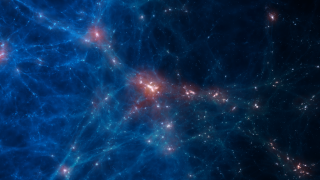Crain, R. A.; Schaye, Joop; Bower, Richard G.; Furlong, Michelle; Schaller, Matthieu; Theuns, Tom; Dalla Vecchia, C.; Frenk, Carlos S.; McCarthy, Ian G.; Helly, John C.; Jenkins, Adrian; Rosas-Guevara, Yetli M.; White, Simon D. M.; Trayford, James W.
Referencia bibliográfica
Monthly Notices of the Royal Astronomical Society, Volume 450, Issue 2, p.1937-1961
Fecha de publicación:
6
2015
Número de citas
1000
Número de citas referidas
922
Descripción
We present results from 13 cosmological simulations that explore the
parameter space of the `Evolution and Assembly of GaLaxies and their
Environments' (EAGLE) simulation project. Four of the simulations follow
the evolution of a periodic cube L = 50 cMpc on a side, and each employs
a different subgrid model of the energetic feedback associated with star
formation. The relevant parameters were adjusted so that the simulations
each reproduce the observed galaxy stellar mass function at z = 0.1.
Three of the simulations fail to form disc galaxies as extended as
observed, and we show analytically that this is a consequence of
numerical radiative losses that reduce the efficiency of stellar
feedback in high-density gas. Such losses are greatly reduced in the
fourth simulation - the EAGLE reference model - by injecting more energy
in higher density gas. This model produces galaxies with the observed
size distribution, and also reproduces many galaxy scaling relations. In
the remaining nine simulations, a single parameter or process of the
reference model was varied at a time. We find that the properties of
galaxies with stellar mass ≲ M⋆ (the `knee' of the
galaxy stellar mass function) are largely governed by feedback
associated with star formation, while those of more massive galaxies are
also controlled by feedback from accretion on to their central black
holes. Both processes must be efficient in order to reproduce the
observed galaxy population. In general, simulations that have been
calibrated to reproduce the low-redshift galaxy stellar mass function
will still not form realistic galaxies, but the additional requirement
that galaxy sizes be acceptable leads to agreement with a large range of
observables.
Proyectos relacionados

Astrofísica Numérica: Formación y Evolución de Galaxias
Entre las cuestiones fundamentales en Astronomía y Astrofísica están la formación y evolución de galaxias. Las escalas de tiempo y tamaño son tan astronómicas que su observación en galaxias individuales es imposible. Solo con el uso de simulaciones numéricas es posible entender la formación de estructuras cósmicas dentro del actual marco
Claudio
Dalla Vecchia